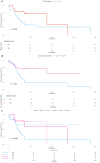Genomic instability and CCNE1 amplification as emerging biomarkers for stratifying high-grade serous ovarian cancer
- PMID: 40842600
- PMCID: PMC12364670
- DOI: 10.3389/fonc.2025.1633410
Genomic instability and CCNE1 amplification as emerging biomarkers for stratifying high-grade serous ovarian cancer
Abstract
Introduction: Ovarian cancer (OC) is one of the leading causes of cancer-related death in women worldwide. Treatment with PARP-inhibitors has significantly improved survival in patients with high-grade serous cancer (HGSC) bearing BRCA1/2 mutations (~22% of the cases), and/or homologous recombination deficiency (HRD, ~50%). Unfortunately, limited therapeutic alternatives are available for BRCA1/2 wild type/HR proficient HGSC patients, who usually exhibit resistance to standard treatments and poor prognosis.
Methods: Herein, we present the results of a comprehensive genomic profiling (CGP) analysis using the Oncomine Comprehensive Assay® (OCA) Plus in a consecutive retrospective cohort of 102 HGSC patients characterized in our institution.
Results: Genomic instability, measured by Genomic Instability Metric (GIM) >16, was found in 40% of the cases and was significantly associated with BRCA1/2 mutations (p=0.009), with a better prognosis in terms of recurrence-free survival (p=0.01). CCNE1 amplification was observed in 29% of cases and was negatively correlated with BRCA1/2 mutations (p=0.001), without any association with GIM, supporting CCNE1 as a strong and independent driver of tumorigenesis. Additionally, CCNE1 amplification was validated with fluorescent in situ hybridization (FISH), supporting the analytical robustness of NGS data (rho=0.93), and investigated by immunohistochemistry (IHC), revealing that CCNE1 protein overexpression was observed in the absence of gene amplification in 45% of cases.
Discussion: Our real-world study supports the clinical utility of the GIM metric and the analytical validity of CCNE1 amplification, a new promising biomarker for personalizing treatment in HR proficient HGSC patients. The discordance between CCNE1 amplification and protein expression raises intriguing questions about the mechanisms of CCNE1-driven tumorigenesis and warrants further investigation.
Keywords: CCNE1 amplification; comprehensive genomic profiling (CGP); high-grade serous ovarian cancer (HGSC); homologous recombination deficiency (HRD) score; precision oncology cancer.
Copyright © 2025 Conca, Lorenzini, Minna, Agnelli, Duca, Gentili, Bodini, Polignano, Mantiero, Damian, Devecchi, Dagrada, Carminati, Ardore, Barbetta, Da Chuna, Guerrizio, Busico, Capone, Piccolo, Tamborini, Perrone, Milione, Paolini, Vingiani, Raspagliesi, De Braud and Pruneri.
Conflict of interest statement
Authors LA and FP are consultant for Roche. The remaining authors declare that the research was conducted in the absence of any commercial or financial relationships that could be construed as a potential conflict of interest.
Figures






References
LinkOut - more resources
Full Text Sources
Miscellaneous

